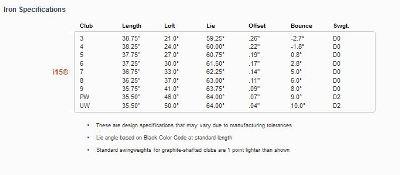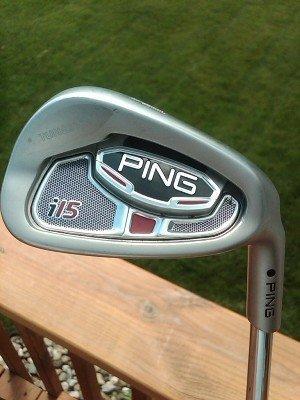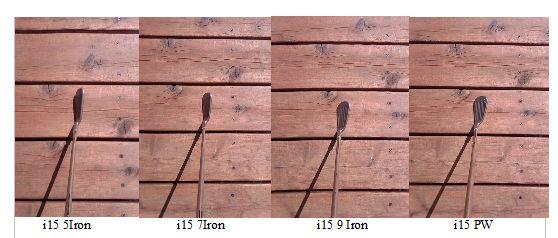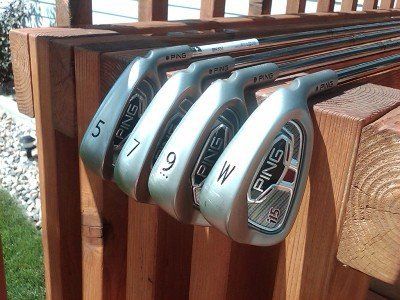Ping i15 iron review
Where do you begin on something like this? Normally when I start my reviews I like to give a little history of the company to familiarize our readers, in this case though I’m quite sure this company needs absolutely no introduction. I could turn this into a history lesson if you’d like, but I’m guessing that is not exactly what you’re here for so I’ll spare you the 50 year history lesson and keep this mostly about the new Ping i15 irons. I can’t continue without at least taking a quick look back at Ping’s history making irons though. Karsten Solheim first began experimenting with making a better iron clear back in 1961 with his heel-toe weighted design which was birth of the cavity back type of irons as all know and love today. It wasn’t until 1975 that the original Ping Eye iron is introduced; the club featured the patented “eye” shape in the cavity for improved feel. The Ping Eye iron would become the new standard for aesthetics on cavity back clubs, and as they say, the rest is history.
Ping irons have enjoyed a great deal of presence and success on professional tours since the birth of the Eye and of course ultimately another game changing iron with the Ping Eye 2, so here we are 25 years into it for Ping and we’ve now got an iron like the Ping i15 to help us shoot better scores. While it is fun to think about it, the i15 does not necessarily continue on from the original “Eye” series irons from the 70’s, Ping has actually been a little bit all over the map with naming irons, we’ve had Zing, Zing 2, ISI, i3, Rapture, i5, all in no particular order of course, but you get the picture clearly I think. Of all these Ping irons available I have actually never really spent much time playing or testing them at all to be quite honest, so to me the Ping i15 was somewhat of an introduction to a historical club making icon.
First here are some features and other technical information from Ping:

The stainless-steel iron features a tungsten toe insert to add forgiveness to the mid-size design. A stabilizing bar and a new Custom Tuning Port (CTP) provide the feel and sound attributes preferred by better players. The cavity design features dual stabilizing bars and a new CTP shape to support the face for a solid feel and sound across the hitting surface. The center of gravity is optimized to provide the trajectory control preferred by better players. In the design of the i15 iron, Ping engineers focused on the better player who prefers an iron set that offers the control to play a variety of shots. Created as a progressive set, the longer irons are larger for more forgiveness. The mid- and short-irons are smaller to ensure workability and control on approach shots.
I am a fan of the progressive iron set myself, I had an old set of Nike Pro Combo that originally started the trend and can say that I like it, but the thing I wasn’t crazy about was the substantial difference in the look and feel of the longer irons compared to the shorter “blade” irons. With the i15 there really isn’t much of a difference like that, to look at them you really don’t notice but when it comes to hitting those tough to hit longer irons you really notice the difference and come to appreciate not being afraid of the long irons, while I don’t think this spells death to the hybrid market I do think that a lot of better players who still like their 3, 4, and 5 irons will appreciate this.
Immediately I liked the looks of the i15 irons and the second I unboxed them I headed straight to the driving range. The first thing I noticed was how much lighter they felt than my forged Mizuno MP-57 irons. The i15 iron is made out of 17-4 stainless steel with a tungsten toe weight to help add forgiveness to the mid-sized design. At first the light weight of the club head left me expecting a less forgiving club but after a few swings with it on the driving range I was happy with the feel and forgiveness they offered. Distance wise the i15 was probably 1/2 to a full club longer than my Mizuno’s, at first I figured it had to be due to stronger lofts but it turns out that the 5-irons of each set match up lofts precisely. The Ping 7 and 9 irons are 2 full degrees stronger and a definite distance increase can be expected there, the PW compared to a 1 degree stronger loft than my set and played to about the same distance my 9 iron usually travels. At first the weight of the head messed with me resulting in my over swinging most of the time, but after using the i15 I definitely became more comfortable with them.
As I said earlier, I currently play a forged set of irons and my set prior to the Mizuno’s I’m playing now were forged so for me the biggest transition was getting used to the difference in feel. I love the soft feel I get from a forged iron and went into this review knowing that I would not be feeling the same buttery feel I’m used to, I was pleasantly surprised though, while not as soft feeling as what I’m used to the Ping i15 did actually have a pretty good feel to me. This comes from the tungsten toe weight, that and Ping’s new Custom Tuning Port really did help out in the feel category as far as I’m concerned. Again, not the soft forged iron I’m used to, but certainly not bad because of it. Just different and that was probably the thing that I had to adapt to the most.
Trajectory wise the Ping i15 is designed to produce a mid-range ball flight, I found myself hitting them quite a little bit higher than my own set, most of the time resulting in a similar overall shot distance and actually helping me to hold greens as a result. Described as a medium top line from Ping I tend to agree with them there, the iron provides a confident look at address with a top line that was not too wide, yet not overly narrow either so in that respect you’d have to call it medium, just as described by Ping. I don’t typically work the flight of my ball one way or the other, usually for me a straight shot with the distance I expect is just what I look for. I do feel that the size and dimensions of the i15 would allow for those looking to work the ball left or right without much of a problem, being a mid-sized iron with not too much off-set should give better players the feel they desire to produce whatever shot shape they’re looking for.
At the end of the day the Ping i15 is definitely a solid club in their current fleet of iron offerings, I don’t think it will quite be the industry changer that the original Ping Eye and Ping Eye 2 were, but at this point in the game I don’t see that type of innovation from anyone for that matter. For Ping fans they’re going to be very happy with the overall looks and performance from the i15, but personally I’m a forged iron guy and I think I’d be more apt to wait around and see what Ping will have to offer guys like me in the future. It’s obvious that Ping knows how to build a good solid iron; after all, they’ve got 50 plus years of experience behind them. To read more on the i15 irons and other Ping equipment you can visit their website here.















solid review P4B….did you only review the 5,7,9,PW? seems to me that you were very pleased overall, and that has to speak volumes, especially coming from a guy who has mizzie’s in the bag.
Awesome review Jason! I noticed a higher trajectory with the G15’s I’m testing/reviewing as well
Thanks for the review, Jason. I really want to give PING a try soon.
Great review Jason, I have ben looking into getting some new irons and have recently added Ping into the mix. This review has been very informative and will help me with my search.
Great review Jason! I cant wait to give these a swing in September
Tired of obtaining low numbers of useless visitors for your site? Well i wish to let you know about a brand new underground tactic that produces myself $900 daily on 100% AUTOPILOT. I could truthfully be here all day and going into detail but why dont you just check their website out? There is a great video that explains everything. So if your seriously interested in producing quick money this is the site for you. Auto Traffic Avalanche
Sick and tired of obtaining low amounts of useless visitors to your website? Well i want to tell you about a new underground tactic that makes myself $900 daily on 100% AUTOPILOT. I really could be here all day and going into detail but why dont you simply check their website out? There is a excellent video that explains everything. So if your seriously interested in making effortless hard cash this is the website for you. Auto Traffic Avalanche
Sorry for the vast critique, but I’m really affectionate the new Zune, and wish this, as wellspring as the fantabulous reviews whatsoever additional love scripted, give provide you settle if it’s the moral choice for you.
Excellent review. I just got fitted with the i15’s. This review really hits home for me. I also play Mizuno clubs. I have the MP-30’s. Although I love the feel of these clubs, I hit the ball much lower with them. The long irons have always been a struggle for me with the Mizuno’s. With the fitting of the i15’s, the first thing I noticed was I got much more height with these clubs. In addition, I’ve found the distance just as the review said. I’m at least a half to a full club length longer. With the i15’s I hit my 7 iron 155-160 yards. With my Mizuno’s I was 10 yards less. The i15’s most definitely are lighter and this will get a little getting used to. However a couple of range sessions and everything fell into place. This is my first experience with Ping and so far I like what I see. There is definitely a difference in the workability of the i15’s and the G15’s. The G15’s go straight, so you pretty much have to go for the center of the green. You’re not going to be able to hit a soft fade or draw to a tough pin placement. If your a good putter then it won’t make much difference. Pars are good but birdies are better. I consider the i15’s great clubs. You can also get a vibration dampening device put in the shaft which I did. Makes a big difference in the feel. Also if you have problems with tennis elbow, this dampening device really cuts the vibration of the club way down on mishits.
When Ping came out with the S56’s, I thought that was the club for me. I’ve been playing Lynx Parallax circa Freddy 80’s w/graphite shafts and was due for a new set. Was tired of shooting between 85-95 and was looking to improve my game hopefully with modern equipt. I went to the Ping factory since I live 40 minutes away to test them out and get a club fitting. What I found out was my length was fine but the disbursement was crappy with the S56’s since they’re similar to blades. They had me try out the i15’s and my scatter was the size of a hula hoop. I’ve been using them for 6 months now, and love them. I went with steel shafts with Cushin inserts to help with the feel and love the fact I can work the ball left or right and am much improved/comfortable with my long irons (4 & 3). I’m now a 10.03 handicap and most of my rounds have been in the low 80’s with a 79 personal best recently. My 7 iron is good for 165 where my 3 (when hit flush) is good for 210. I’ll attribute my game improvement to range time but it was these clubs that got me out there. Simply love ’em.
I have now had two sets of I15 irons and on both occasions the Ping swing weight keeeps falling out with normal use due to the glue holding it in not being able to take the force of the impact on the club face.
I have been exploring for a bit for any high quality
articles or blog posts in this kind of house . Exploring in Yahoo I ultimately stumbled
upon this web site. Reading this info So i’m glad to convey that I’ve an incredibly just right uncanny feeling I came upon exactly
what I needed. I most for sure will make certain to don?
t put out of your mind this web site and provides it a look on a constant basis.
Excellent article! We will be linking to this particularly great article on our site.
Keep up the great writing.
Can anyone tell me the official color used on the i15 head? The paint is coming off of mine a bit and i would like to touch it up.
Previous reviewer Dave here… I cant believe I came across this article 10 years later! I STILL am playing my Ping I15’s and a Ping G20 driver, not because I’m cheap but because I haven’t found a better replacement. I’m currently a 5.7 HC now although I’ve avg’d 7-8 the last 3-4 years and just previous to that, I got as low as a 5.1 HC. When I posted my 1st review here, I was 44 and now that I’m 54, I’ve lost a few yards in distance where my 7 iron only carry’s about 155-160 now. It could be time to re-fit my irons as I’ve never done it since purchase but I’m pretty sure it’s just my swing speed down about 5 MPH or so. In that 10 yr span I took three 1 hour lessons about 6 or 7 years ago and I’m about to see a new guy this Saturday with a goal to be a solid sub-5 HC player… just for fun, a beer or lunch bets, no tourney’s. Golf is truly one of the greatest sports ever.